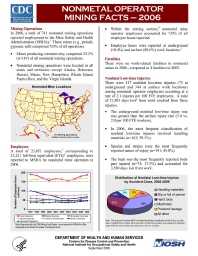Mining Publication: Nonmetal Operator Mining Facts - 2006
Original creation date: September 2008
Mining Operations: In 2006, a total of 741 nonmetal mining operations reported employment to the Mine Safety and Health Administration (MSHA). These mines (e.g., potash, gypsum, salt) comprised 5.0% of all operations. Mines producing common clay comprised 25.2% (n=187) of all nonmetal mining operations. Nonmetal mining operations were located in all states and territories except Alaska, Delaware, Hawaii, Maine, New Hampshire, Rhode Island, Puerto Rico, and the Virgin Islands. Employees: A total of 23,051 employees, corresponding to 23,221 full-time equivalent (FTE) employees, were reported to MSHA by nonmetal mine operators in 2006. Within the mining sectors, nonmetal mine operator employees accounted for 7.0% of all employee hours reported. Employee hours were reported at underground (10.4%) and surface (89.6%) work locations. Fatalities: There were no work-related fatalities in nonmetal mines in 2006, compared to 4 fatalities in 2005. Nonfatal Lost-time Injuries: There were 417 nonfatal lost-time injuries (73 at underground and 344 at surface work locations) among nonmetal operator employees occurring at a rate of 2.1 injuries per 100 FTE employees. A total of 21,893 days lost from work resulted from these injuries. The underground nonfatal lost-time injury rate was greater than the surface injury rate (3.0 vs. 2.0 per 100 FTE workers). In 2006, the most frequent classification of nonfatal lost-time injuries involved handling materials (n=163; 39.1%). Sprains and strains were the most frequently reported nature of injury (n=191; 45.8%). The back was the most frequently reported body part injured (n=73; 17.5%) and accounted for 3,589 days lost from work.
Authors: National Institute for Occupational Safety and Health
Brochure/flyer - September 2008
NIOSHTIC2 Number: 20034771
Pittsburgh, PA: U.S. Department of Health and Human Services, Public Health Service, Centers for Disease Control and Prevention, National Institute for Occupational Safety and Health, DHHS (NIOSH) Publication No. 2008-161, 2008 Sep; :1-2
See Also
- Coal Operator Mining Facts - 2005
- Metal Operator Mining Facts - 2002
- Metal Operator Mining Facts - 2004
- Metal Operator Mining Facts - 2005
- Noncoal Contractor Mining Facts - 2003
- Nonmetal Operator Mining Facts - 2002
- Nonmetal Operator Mining Facts - 2008
- Sand and Gravel Operator Mining Facts - 2006
- Stone Operator Mining Facts - 2003
- Stone Operator Mining Facts - 2005
- Page last reviewed: 9/21/2012
- Page last updated: 9/21/2012
- Content source: National Institute for Occupational Safety and Health, Mining Program


 ShareCompartir
ShareCompartir
